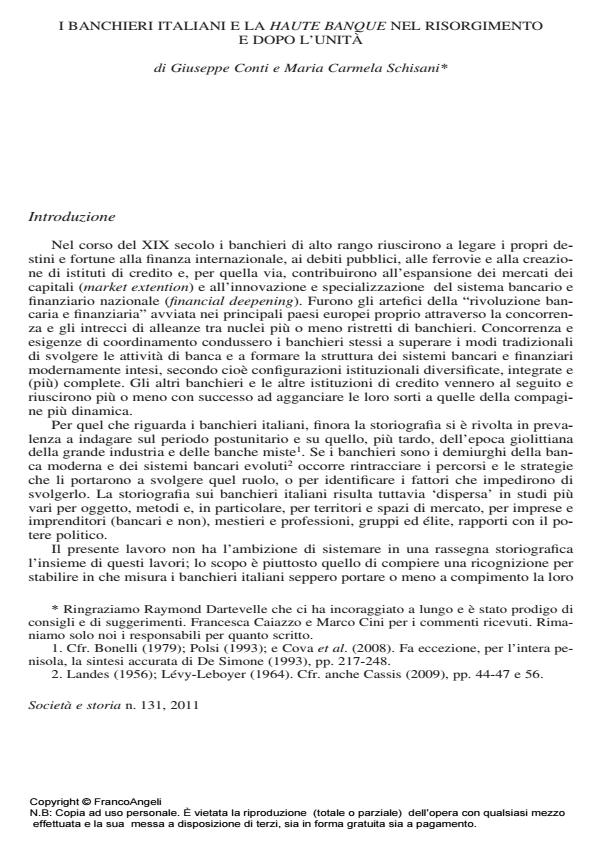The italian bankers and the haute banque in the Risorgimento and after the unification
Journal title SOCIETÀ E STORIA
Author/s Giuseppe Conti, Maria Carmela Schisani
Publishing Year 2011 Issue 2011/131 Language Italian
Pages 38 P. 133-170 File size 749 KB
DOI 10.3280/SS2011-001005
DOI is like a bar code for intellectual property: to have more infomation
click here
Below, you can see the article first page
If you want to buy this article in PDF format, you can do it, following the instructions to buy download credits

FrancoAngeli is member of Publishers International Linking Association, Inc (PILA), a not-for-profit association which run the CrossRef service enabling links to and from online scholarly content.
In the mid-19th century Europe, the financial revolution - namely both the making of "modern" bank and of financial markets related to the development of joint-stock companies - was carried out by the merchant-bankers. In Italy, this role was strongly penalized by the difficulties that the bankers found in specializing, in coordinating and both in seizing room and roles in an integrated market. Actually, their action was limited by an economic background influenced by the political division of Italy and consequently too centred on local interests. An element which drove Italian bankers to change was the competition with the haute-banque but, at the same time, this was an element that weakened the possibility for them to launch their independent projects. Particularly, the Italian political division both resulted in the creation of a national market for public securities and in a delay in issuing private securities (i.e. railways and banks). In pre-unitary states, Italian bankers took lots of financial initiatives but only few enterprises had good results. 1848 represented a watershed in the development of public debt as well as of banking institutions. Before this year, the kingdom of Naples and the Papal state showed a very rapid increase in their public debts, essentially due to the financial emergences of the "Restorations" (1815, 1821, 1831). While, other states, Piedmont above all, increased their debt levels after 1848 in order to fund the Wars of Independence and railway constructions as well. After the Italian Unification the difficulties met by the integration process marked the persistence of different and divergent social and territorial interests producing the failure of the Cavourian project for credit centralization (i.e. one issuing bank, one large land credit bank). Different solutions prevailed and this was a big limit to the development of private bank in Italy and entailed that international finance did not reduce its influence on the Italian financial system.
Keywords: Merchant bankers, <i>haute banque</i>, public debt, banking development, Italian Risorgimento
- Alessandro Torlonia Daniela Felisini, pp.107 (ISBN:978-3-319-41997-8)
- Private Bankers in the Italian 19th Century Luciano Maffi, pp.131 (ISBN:978-3-030-63360-8)
- Private Bankers in the Italian 19th Century Luciano Maffi, pp.1 (ISBN:978-3-030-63360-8)
- Private Bankers in the Italian 19th Century Luciano Maffi, pp.47 (ISBN:978-3-030-63360-8)
- La storia economica contemporanea in quaranta anni di "Società e storia" Marco Doria, in SOCIETÀ E STORIA 178/2023 pp.783
DOI: 10.3280/SS2022-178007 - Crowding out the change: business networks and persisting economic elites in the South of Italy over Unification (1840–1880) Maria Carmela Schisani, Luigi Balletta, Giancarlo Ragozini, in Cliometrica /2021 pp.89
DOI: 10.1007/s11698-020-00204-3 - Private Bankers in the Italian 19th Century Luciano Maffi, pp.83 (ISBN:978-3-030-63360-8)
- The ripples of the industrial revolution: exports, economic growth, and regional integration in Italy in the early nineteenth century Giovanni Federico, Antonio Tena-Junguito, in European Review of Economic History /2014 pp.349
DOI: 10.1093/ereh/heu007
Giuseppe Conti, Maria Carmela Schisani, I banchieri italiani e la <i>haute banque</i> nel Risorgimento e dopo l’Unità in "SOCIETÀ E STORIA " 131/2011, pp 133-170, DOI: 10.3280/SS2011-001005